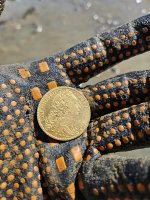E
elle
Guest
Hi,
I was wondering if anyone out there who has worked the 1715 fleet sites, or beachcombers in the vicinity of these wrecks, ever came across a particular wood called alder.
I know there are many species of alder, but I am looking for the one that is reddish-brown in color, containing streaks and dark lines. While going through your shoebox of artifacts, look for a hardwood that is very distinctive in appearance. To describe, it is fine-grained, elastic, coarse and dense. Alder can also be easily worked, allowing fine details to be carved into it. If you’re not sure, I’d be more than happy to help identify.
Carpenters mainly sought this wood for the ship planking, but I am in need to find any evidence of this wood, despite its origin of use or structure location.
If anyone remembers a story or discovery of alder from the 1715 fleet, could you please p.m. me? I thank everyone 2 million times for taking the time to help me out with my research!
Laura J
I was wondering if anyone out there who has worked the 1715 fleet sites, or beachcombers in the vicinity of these wrecks, ever came across a particular wood called alder.
I know there are many species of alder, but I am looking for the one that is reddish-brown in color, containing streaks and dark lines. While going through your shoebox of artifacts, look for a hardwood that is very distinctive in appearance. To describe, it is fine-grained, elastic, coarse and dense. Alder can also be easily worked, allowing fine details to be carved into it. If you’re not sure, I’d be more than happy to help identify.
Carpenters mainly sought this wood for the ship planking, but I am in need to find any evidence of this wood, despite its origin of use or structure location.
If anyone remembers a story or discovery of alder from the 1715 fleet, could you please p.m. me? I thank everyone 2 million times for taking the time to help me out with my research!
Laura J




